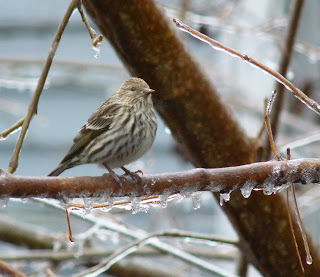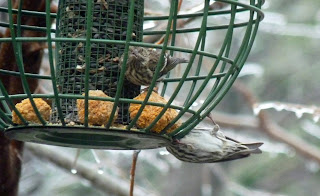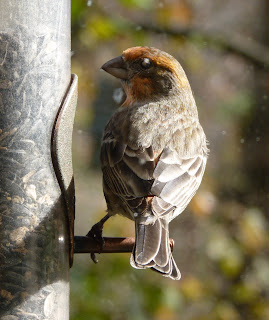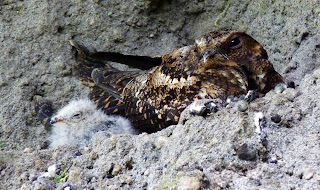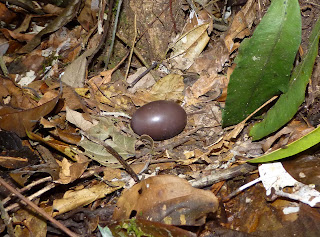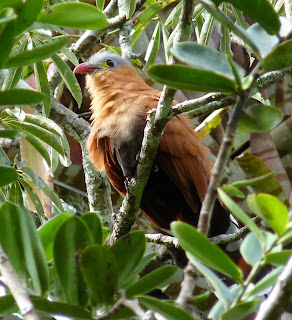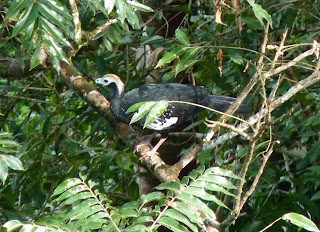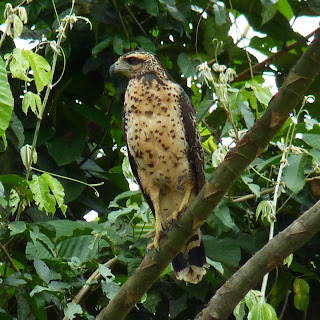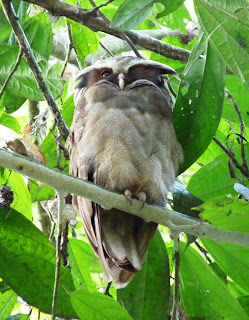I signed up to help out with four Christmas Bird Counts (CBCs) in North Carolina this year: Durham, Chapel Hill, Bodie/Pea Island and Mattamuskeet.
Yeah, it sounds like a lot of work to go out and count every single sparrow and chickadee, but it helps contribute to a long-running data set. And these counts are also a great chance to get out with some fantastic birders who have fantastic scopes, which greatly increases the odds of seeing rarities.
An unusual early snowstorm made for an especially wintery feel to the counts this year. And I was among the many people who skipped the Chapel Hill CBC to go sledding; Yahoo! I did see some decent birds on the Al Buehler Trail on my way to the Duke Golf Course--a CBC no man's land stuck between the Durham and Chapel Hill count circles.
I can't even remember if I participated in the Durham CBC last year, but the memory of this years' should last awhile! The above comment about scopes didn't hold true as Doug Shadwick and this professional birder from France took their fancy scopes off to some wind-sheltered field leaving Robert Meehan and me to cover the frozen windswept section of Falls Lake by the railroad grade using Robert's "Parkinson's disease" tripod to attempt to count unidentifiable "ducks" several miles away.
Despite this handicap we found quite a few lingering shorebirds including these Dunlin who were out ice-skating.

But the most unusual find was a blue form Snow Goose that flew over us early. After we finished counting we went on a short wild goose chase and found the flock by a nearby pond where it had already been spotted by another birding party.
 Brian Bockhahn has way better pictures from when the goose was much closer.
Brian Bockhahn has way better pictures from when the goose was much closer.
Of course a Snow Goose goes from being a highlight in Durham to becoming merely one of several thousand "Down East."
One odd Cackling Goose hanging out with a flock of snows was the celebrity goose of the Bodie/Pea Island CBC and a new NC bird for me.
 (Hooray for two awful goose pictures!; see Ali Iyoob's way better photo)
(Hooray for two awful goose pictures!; see Ali Iyoob's way better photo)
Our party's best find was this White-winged Dove we stumbled upon at North Bodie (Life bird #1446!). I've been double-checking every Mourning Dove since.

But our rarity was eclipsed by other ridiculous sightings of Black Rail, Long-eared Owl and two Saw-whet Owls! Unfortunately only a few people got to see these rare and impossible to see species and I was not among them.
I did catch a fleeting glimpse of a Virginia Rail, which I'll count as a state bird, since I had previously seen one in Vermont. I also saw my first Sedge Wrens in NC by the Bodie Lighthouse at dusk. My "Grass Wren" sighting in Ecuador kept this from being a life bird.
I did get a second life-bird (#1447) for the day in an Orange-crowned Warbler at North Pond. I had poorly seen, but not counted one last year at Mattamuskeet, so I was glad to finally get a good look at one.
Fittingly, Orange-crowned Warblers seemed to be all over the place the next day at the Mattamuskeet CBC. But my best warbler there was definitely the Yellow-throated I found with a flock of Pine Warblers near the south end of the causeway.
Other state birds for the day were Common Moorhen,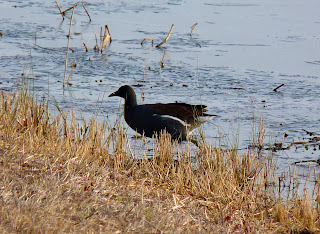 Canvasback and Common Merganser, but after hours of birding I had not seen a life bird; no Eurasian Wigeon or Golden Eagle. But just before sunset Brian and his party told us about a couple Clay-colored Sparrows nearby in a yard. Ali kindly showed us the spot and my 1448th life bird (thanks Ali!; his photo).
Canvasback and Common Merganser, but after hours of birding I had not seen a life bird; no Eurasian Wigeon or Golden Eagle. But just before sunset Brian and his party told us about a couple Clay-colored Sparrows nearby in a yard. Ali kindly showed us the spot and my 1448th life bird (thanks Ali!; his photo).
On our way back down the causeway we spotted an American Bittern standing awkwardly by the roadside away from cover for #1449. I was pretty excited about this since Robert had seen three invisible bitterns over the past couple days while I was standing next to him.
So in just two days I was able to see four life birds and 12 state birds (those mentioned above plus Merlin and Black Scoter, which should bring my NC list up to 230); not bad at all!
It's amazing how ubiquitous the snipe are in the Mattamuskeet area as it seemed like there was one in every front yard.
A quick shout-out to Ali, Matt Daw and Kyle Kittleberger. It's great to see young people into birding and at 16(ish), these Raleigh kids are metaphorical zygotes to the birding world. Yet they are already such knowledgeable, intelligent birders. Their exuberance is infectious and their nonstop bird story-telling made the drive home go quickly.
Before I end I have to reprimand everybody for losing my nest quiz from last time by not guessing.
In fact hardly anyone even read the last post. I guess the septuagenarian backyard bird-feeder theme is revolting to the modern birder hoping to shed such stereotypes.
But for all zero of you who were curious, the answer was Band-winged Nightjar.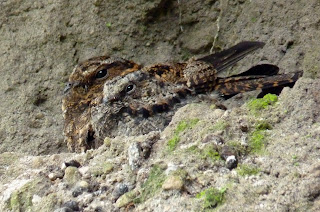
Here's the follow-up shot up of the fledgling starting to resemble mom. I did find this nest around 1300 meters elevation--about 500 meters below its altitude range (Ridgley and Greenfield) so its identity was a bit of a surprise once I finally worked it out.
Coming very soon... My top ten bird sightings of 2010!
Stay tuned...
Yeah, it sounds like a lot of work to go out and count every single sparrow and chickadee, but it helps contribute to a long-running data set. And these counts are also a great chance to get out with some fantastic birders who have fantastic scopes, which greatly increases the odds of seeing rarities.
An unusual early snowstorm made for an especially wintery feel to the counts this year. And I was among the many people who skipped the Chapel Hill CBC to go sledding; Yahoo! I did see some decent birds on the Al Buehler Trail on my way to the Duke Golf Course--a CBC no man's land stuck between the Durham and Chapel Hill count circles.
I can't even remember if I participated in the Durham CBC last year, but the memory of this years' should last awhile! The above comment about scopes didn't hold true as Doug Shadwick and this professional birder from France took their fancy scopes off to some wind-sheltered field leaving Robert Meehan and me to cover the frozen windswept section of Falls Lake by the railroad grade using Robert's "Parkinson's disease" tripod to attempt to count unidentifiable "ducks" several miles away.
Despite this handicap we found quite a few lingering shorebirds including these Dunlin who were out ice-skating.

But the most unusual find was a blue form Snow Goose that flew over us early. After we finished counting we went on a short wild goose chase and found the flock by a nearby pond where it had already been spotted by another birding party.
 Brian Bockhahn has way better pictures from when the goose was much closer.
Brian Bockhahn has way better pictures from when the goose was much closer.Of course a Snow Goose goes from being a highlight in Durham to becoming merely one of several thousand "Down East."
One odd Cackling Goose hanging out with a flock of snows was the celebrity goose of the Bodie/Pea Island CBC and a new NC bird for me.
 (Hooray for two awful goose pictures!; see Ali Iyoob's way better photo)
(Hooray for two awful goose pictures!; see Ali Iyoob's way better photo)Our party's best find was this White-winged Dove we stumbled upon at North Bodie (Life bird #1446!). I've been double-checking every Mourning Dove since.

But our rarity was eclipsed by other ridiculous sightings of Black Rail, Long-eared Owl and two Saw-whet Owls! Unfortunately only a few people got to see these rare and impossible to see species and I was not among them.
I did catch a fleeting glimpse of a Virginia Rail, which I'll count as a state bird, since I had previously seen one in Vermont. I also saw my first Sedge Wrens in NC by the Bodie Lighthouse at dusk. My "Grass Wren" sighting in Ecuador kept this from being a life bird.
I did get a second life-bird (#1447) for the day in an Orange-crowned Warbler at North Pond. I had poorly seen, but not counted one last year at Mattamuskeet, so I was glad to finally get a good look at one.
Fittingly, Orange-crowned Warblers seemed to be all over the place the next day at the Mattamuskeet CBC. But my best warbler there was definitely the Yellow-throated I found with a flock of Pine Warblers near the south end of the causeway.
Other state birds for the day were Common Moorhen,
 Canvasback and Common Merganser, but after hours of birding I had not seen a life bird; no Eurasian Wigeon or Golden Eagle. But just before sunset Brian and his party told us about a couple Clay-colored Sparrows nearby in a yard. Ali kindly showed us the spot and my 1448th life bird (thanks Ali!; his photo).
Canvasback and Common Merganser, but after hours of birding I had not seen a life bird; no Eurasian Wigeon or Golden Eagle. But just before sunset Brian and his party told us about a couple Clay-colored Sparrows nearby in a yard. Ali kindly showed us the spot and my 1448th life bird (thanks Ali!; his photo).On our way back down the causeway we spotted an American Bittern standing awkwardly by the roadside away from cover for #1449. I was pretty excited about this since Robert had seen three invisible bitterns over the past couple days while I was standing next to him.
So in just two days I was able to see four life birds and 12 state birds (those mentioned above plus Merlin and Black Scoter, which should bring my NC list up to 230); not bad at all!
It's amazing how ubiquitous the snipe are in the Mattamuskeet area as it seemed like there was one in every front yard.

A quick shout-out to Ali, Matt Daw and Kyle Kittleberger. It's great to see young people into birding and at 16(ish), these Raleigh kids are metaphorical zygotes to the birding world. Yet they are already such knowledgeable, intelligent birders. Their exuberance is infectious and their nonstop bird story-telling made the drive home go quickly.
Before I end I have to reprimand everybody for losing my nest quiz from last time by not guessing.
In fact hardly anyone even read the last post. I guess the septuagenarian backyard bird-feeder theme is revolting to the modern birder hoping to shed such stereotypes.
But for all zero of you who were curious, the answer was Band-winged Nightjar.

Here's the follow-up shot up of the fledgling starting to resemble mom. I did find this nest around 1300 meters elevation--about 500 meters below its altitude range (Ridgley and Greenfield) so its identity was a bit of a surprise once I finally worked it out.
Coming very soon... My top ten bird sightings of 2010!
Stay tuned...

